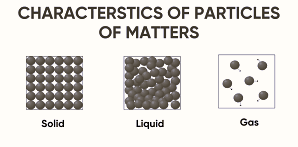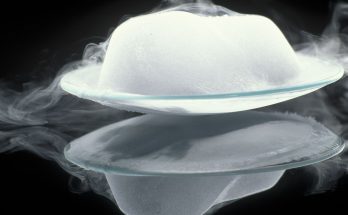Rapid Revision: Matter in Our Surroundings Class 9
Table of Contents
1. Introduction to Matter
Definition of Matter
Anything that has mass and occupies space.
Examples of Matter in Daily Life
Air, water, food, books, plants, animals, sand, clouds, etc.
Panch Tatva (Five Basic Elements in Ancient Philosophy)
Indian and Greek philosophers believed all matter is made of Air, Earth, Fire, Sky and Water.
Modern Classification of Matter
- Based on Physical Properties– Solid, Liquid, Gas.
- Based on Chemical Composition– Elements, Compounds, Mixtures.
Also Check – Chapter 1 -MATTER IN OUR SURROUNDINGS -Class 9 – Simplified detailed Notes
2. Physical Nature of Matter
Matter is Made Up of Particles
It is not continuous but consists of small particles.
Experiment with Salt/Sugar Dissolving in Water
When salt/sugar is added to water, it dissolves without increasing water level → proves particles have space between them.
How Small Are These Particles?
Experiment- Potassium Permanganate Dilution A tiny crystal of potassium permanganate can color a large volume of water. This proves particles are very small and can divide into even smaller units.
3. Characteristics of Particles of Matter
Particles Have Space Between Them
Evidence- When sugar/salt is added to water, it dissolves by filling gaps between water particles.
Particles Are Continuously Moving
Diffusion (spontaneous mixing of substances due to movement of particles)-
- Incense stick experiment- Smell spreads across the room without blowing air.
- Ink in water- Ink spreads and mixes without stirring → proves motion of particles.
Particles Attract Each Other
Different substances have different strengths of attraction-
- Iron nail → Strong force of attraction (hard to break).
- Chalk → Weaker attraction (can be broken easily).
- Rubber band → Can stretch (moderate force).
Key Takeaways for Exam
- Matter is made up of tiny, moving particles.
- Particles have space between them (evidence- dissolving substances).
- Particles are in constant motion (evidence- diffusion of gases & liquids).
- Particles attract each other with varying strengths (solids > liquids > gases).
4. States of Matter
Matter exists in three states-
- Solid
- Liquid
- Gas
Properties of Solids
- Definite shape & volume → Doesn’t change unless force is applied.
- Rigid → Cannot flow.
- Incompressible → Very little space between particles.
- Strong force of attraction between particles.
Examples- Pen, book, wooden block, rubber band (stretches but regains shape), sponge (compressible due to trapped air).
Properties of Liquids
- No fixed shape → Takes the shape of the container.
- Fixed volume → Does not expand to fill space like gases.
- Fluidity → Can flow (unlike solids).
- Diffusion → Liquids can mix with other liquids (e.g., ink in water).
- Moderate force of attraction between particles.
Examples- Water, milk, oil, juice, alcohol.
Properties of Gases
- No fixed shape or volume → Spreads to fill any available space.
- Highly compressible → Can be squeezed into small containers (e.g., LPG cylinders).
- Fast diffusion → Gases mix rapidly (e.g., perfume spreads in a room).
- Weak force of attraction between particles.
Examples- Oxygen (O₂), Carbon dioxide (CO₂), LPG (Liquefied Petroleum Gas), CNG (Compressed Natural Gas), air.
Key Exam Points
- Solids → Definite shape & volume, rigid, incompressible.
- Liquids → No fixed shape, fixed volume, flows, moderate diffusion.
- Gases → No shape/volume, highly compressible, diffuses quickly.
Also Check – Chapter 1- Matter In Our Surroundings – Class 9 Science – Long Question and Answers
5. Change of State of Matter
Matter can change from one state to another by altering temperature or pressure.
Effect of Temperature on State of Matter
- Heating increases kinetic energy → Particles move faster → Overcome force of attraction → Change state.
Melting Point & Latent Heat of Fusion
- Melting Point– Temperature at which a solid turns into a liquid (Ice → Water at 0°C or 273 K).
- Latent Heat of Fusion– Heat energy needed to convert 1 kg of solid into liquid without temperature change.
Boiling Point & Latent Heat of Vaporization
- Boiling Point– Temperature at which a liquid turns into gas (Water → Steam at 100°C or 373 K).
- Latent Heat of Vaporization– Heat required to convert 1 kg of liquid into gas without changing temperature.
Experiments
- Ice melting in a beaker (demonstrates latent heat of fusion).
- Boiling water on a stove (demonstrates latent heat of vaporization).
Effect of Pressure on State of Matter
- Increasing pressure → Brings particles closer → Converts gas to liquid (e.g., LPG & CNG).
- Decreasing pressure → Expands gases (e.g., dry ice or solid CO₂ sublimates at low pressure).
Sublimation (Solid → Gas directly)
Some solids directly convert into gas without becoming liquid.
Examples-
- Camphor
- Naphthalene balls
- Dry ice (solid CO₂)
Experiment- Place camphor/naphthalene on a dish and observe how it disappears without leaving liquid.
Also Check – Sublimation- How Solids Turn Into Gas Without Melting
Also Chekc – NCERT Exemplar Solutions- Class 9 Science Chapter – 1 – Matter in Our Surroundings
Key Exam Points
- Melting Point → Solid to Liquid (Ice to Water).
- Boiling Point → Liquid to Gas (Water to Steam).
- Latent Heat → Extra energy required for state change.
- Sublimation → Solid to Gas (e.g., Camphor, Naphthalene).
- Pressure can liquefy gases (LPG, Dry Ice).
Also Check – Chapter 1- Matter In Our Surroundings – Class 9 Science – Solved MCQs
6. Evaporation and Its Effects
Evaporation is the process where a liquid changes into gas at any temperature below its boiling point.
- Unlike boiling, evaporation occurs only at the surface of a liquid.
Factors Affecting Evaporation
- Surface Area Increases
- More surface area = More particles exposed = Faster evaporation.
- Example- Wet clothes dry faster when spread out.
- Temperature Increases
- Higher temperature = Higher kinetic energy = Faster evaporation.
- Example- Water evaporates faster in summer than in winter.
- Humidity Decreases
- More moisture in the air = Slower evaporation.
- Example- Clothes take longer to dry on a humid day.
- Wind Speed Increases
- Moving air carries away water vapor, increasing evaporation.
- Example- Clothes dry faster on a windy day.
Evaporation and Cooling
- How does evaporation cause cooling?
- Particles with higher energy escape first, leaving the remaining liquid cooler.
- Examples-
- Sweating → Sweat evaporates, absorbing heat from the skin → Body cools down.
- Water in earthen pots → Small pores allow evaporation, cooling the water.
- Acetone (nail polish remover) on skin → Evaporates quickly, absorbing heat, making the skin feel cool.
Key Exam Points
- Evaporation occurs at any temperature below boiling point.
- Faster evaporation with more surface area, higher temperature, low humidity and high wind speed.
- Evaporation causes cooling by absorbing heat.
- Daily life examples- Sweating, earthen pots, acetone cooling effect.
Also Check – Matter In Our Surroundings – Worksheet with Answer Key
7. Interconversion of States of Matter
Matter can change from one state to another by changing temperature or pressure.
Process of State Change-
- Melting (Fusion) → Solid → Liquid
- Example- Ice melting at 0°C (273K)
- Freezing (Solidification) → Liquid → Solid
- Example- Water freezing into ice.
- Boiling (Vaporization) → Liquid → Gas
- Example- Water boiling at 100°C (373K)
- Condensation → Gas → Liquid
- Example- Steam turning into water droplets.
- Sublimation → Solid → Gas (without becoming liquid)
- Example- Camphor, Naphthalene balls.
- Deposition → Gas → Solid (without becoming liquid)
- Example- Frost formation.
Interconversion Flowchart-
- Solid ↔ Liquid ↔ Gas (via Temperature/Pressure changes)
Difference Between Boiling and Evaporation
| Feature | Boiling | Evaporation |
| Definition | Bulk phenomenon- Liquid changes to gas at boiling point. | Surface phenomenon- Liquid changes to gas below boiling point. |
| Temperature | Occurs at a fixed temperature (e.g., 100°C for water). | Happens at any temperature. |
| Speed | Rapid process. | Slow process. |
| Example | Water boiling at 100°C. | Sweat drying from skin. |
Also Check – 82 Reasoning-Based Questions & Answers-Matter In Our Surroundings -Class 9 Science
8. Importance of Latent Heat of Vaporization & Fusion
- Latent Heat is the extra energy required to change state without a temperature change.
- Latent Heat of Fusion– Heat energy required to convert 1 kg of solid into liquid at melting point.
- Example- Ice at 0°C remains ice until all ice melts, even if heat is supplied.
- Latent Heat of Vaporization– Heat energy required to convert 1 kg of liquid into gas at boiling point.
- Example- Water at 100°C remains water until all of it turns into steam.
9. Applications of State Change Concepts in Daily Life
- Melting & Freezing–
- Ice melting into water.
- Freezing of water into ice cubes.
- Boiling & Condensation–
- Water boiling to cook food.
- Steam turning into water droplets on cool surfaces.
- Evaporation & Cooling–
- Sweating helps in cooling the body.
- Earthen pots (Matkas) keep water cool.
- Refrigerators use latent heat for cooling.
- Sublimation & Deposition–
- Naphthalene balls disappear over time.
- Frost formation on cold surfaces in winter.
Key Exam Points
- Interconversion of matter is controlled by temperature & pressure.
- Boiling occurs at a fixed temperature, evaporation happens anytime.
- Latent heat is required for phase changes.
- Real-life applications- Cooling by evaporation, condensation in clouds, refrigeration, etc.
Mnemonic to Remember Interconversions-
M-B-C-S-D → Melting, Boiling, Condensation, Sublimation, Deposition
ensation in clouds, refrigeration, etc.
Mnemonic to Remember Interconversions:
M-B-C-S-D → Melting, Boiling, Condensation, Sublimation, Deposition

